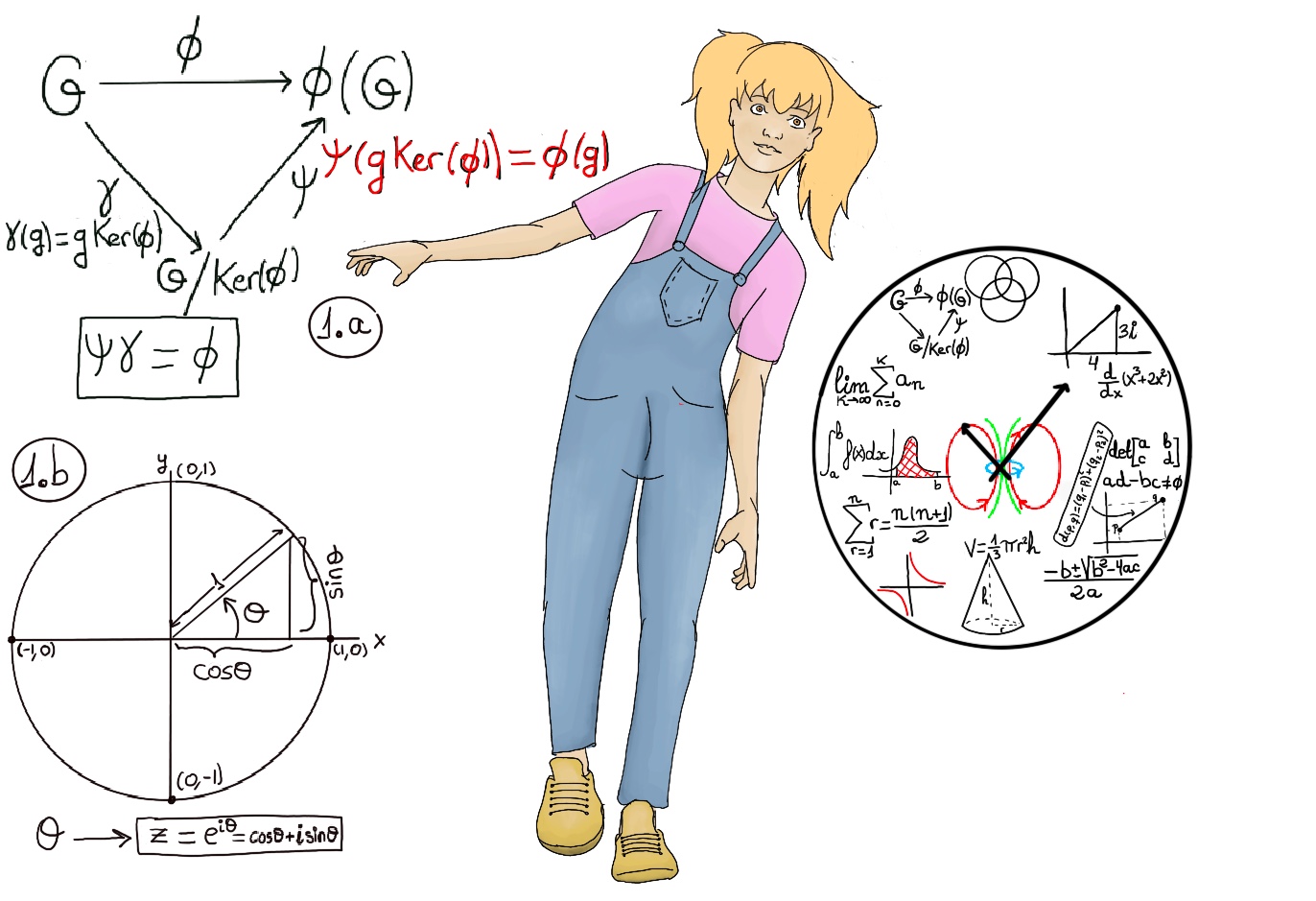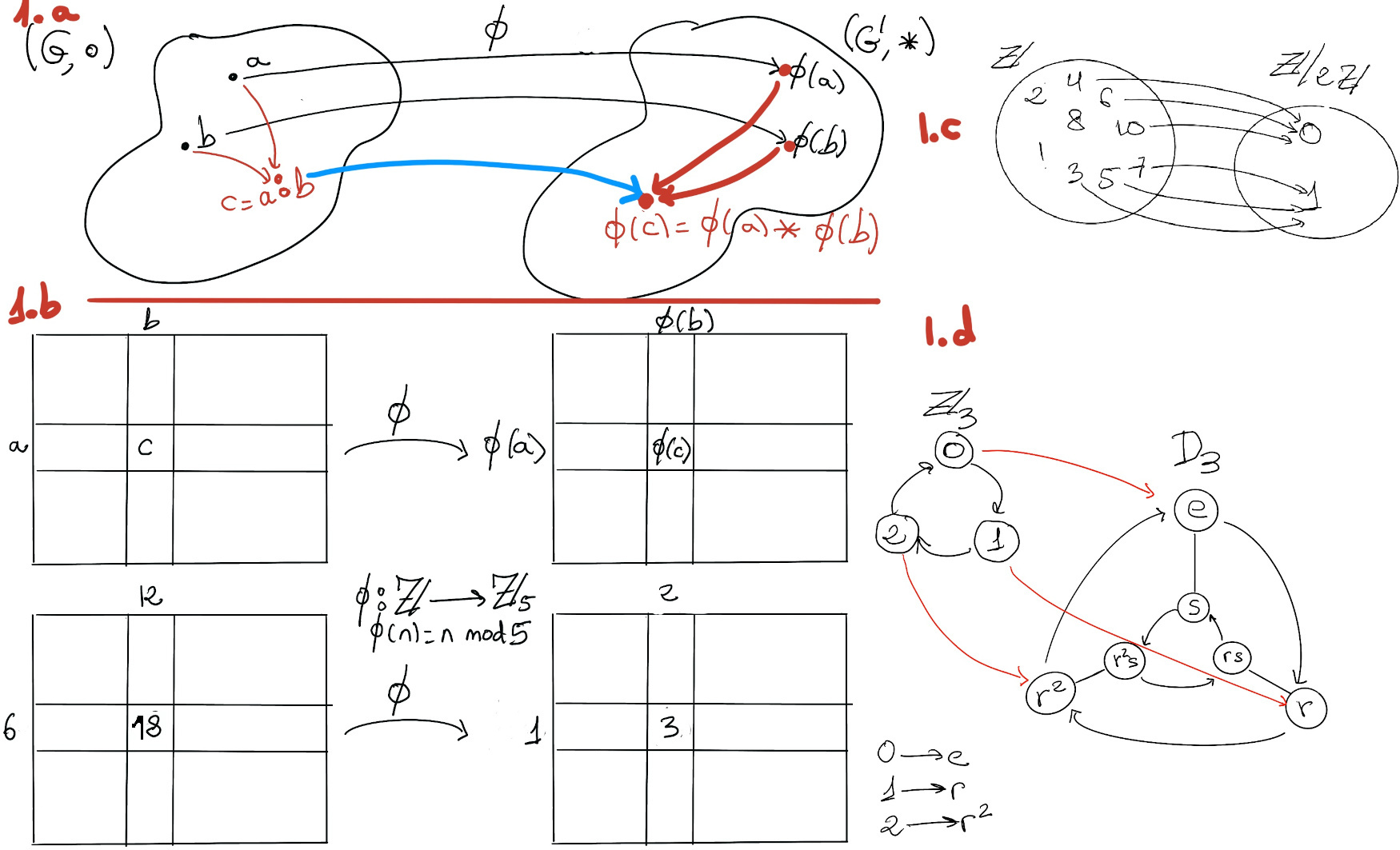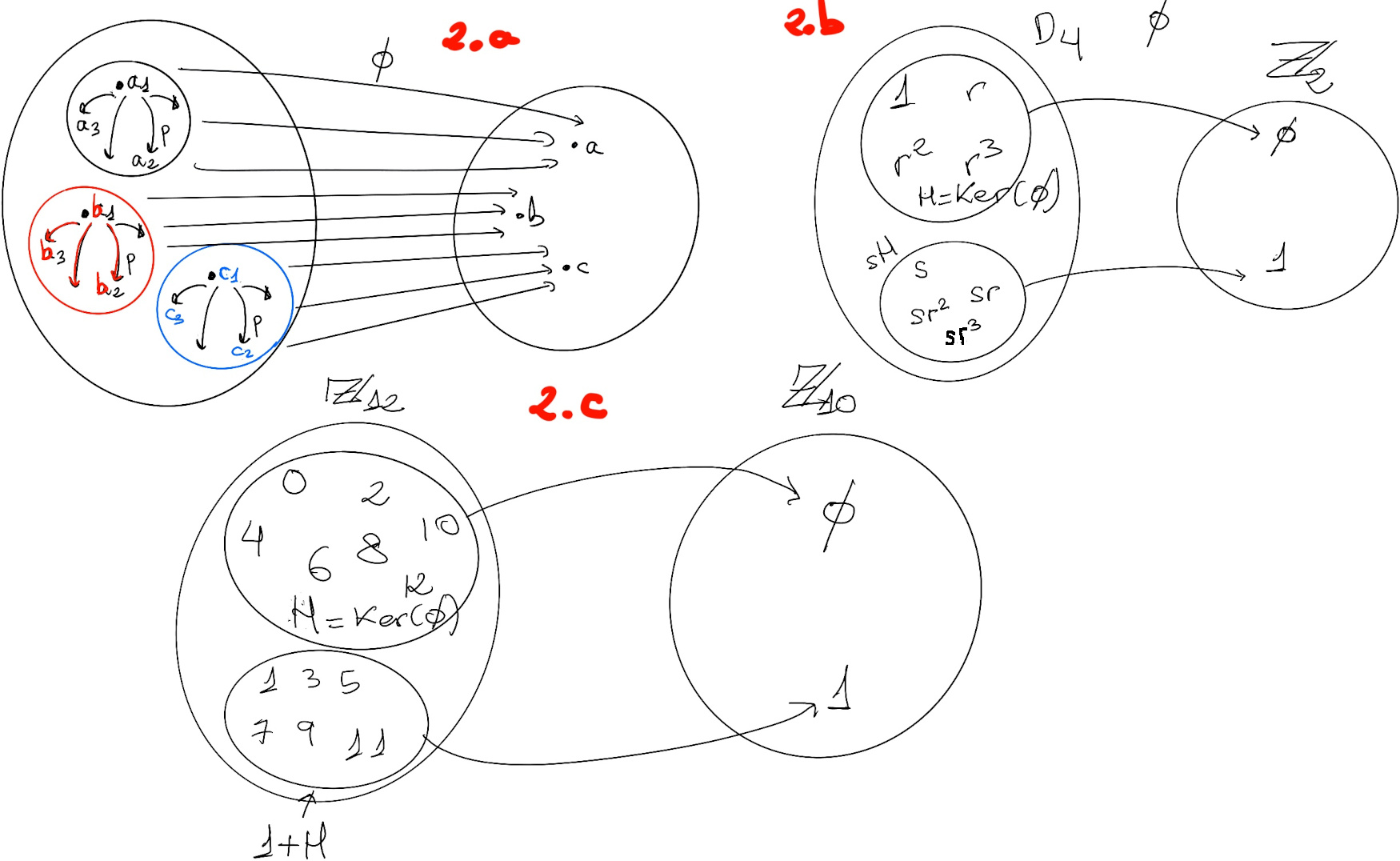
|
 |
 |

|
 |
 |
I was pretty sure that she was planning my murder […] A knife? A too much hands-on approach. Pee on the cooking pot? Too gross. Putting me on a cross and throwing darts at me? Too messianic. A grenade? How will I answer some questions? Where did Dad die, Mum, in the kitchen? -Everywhere, he was everywhere, Apocalypse, Anawim, #justothepoint.
First Isomorphism Theorem. Let Φ be a group homomorphism from G to G’. Then, the function or mapping from G/Ker(Φ) to Φ(G), defined by gKer(Φ) → Φ(g) is an isomorphism, i.e., G/Ker(Φ) ≋ Φ(G). In particular, if Φ is onto, G/Ker(Φ) ≋ G’.

The mapping γ: G → G/Ker(Φ) is defined as γ(g) = gKer(Φ). It is called the natural mapping and is indeed a homomorphism. The Fundamental theorem on homomorphisms or the first isomorphism theorem shows that Ψγ = Φ.
Proof. Let φ: G/Ker(Φ) → Φ(G), φ(aKer(Φ)) = Φ(a).
Corollary. If Φ is a homomorphism from a finite group G to G', then |Φ(G)| divides both |G| and |G'|.
Proof.
By The First Isomorphism Theorem, G/Ker(Φ) ≋ Φ(G) ⇒ [By Lagrange, |G| = |G/Ker(Φ)]·|Ker(Φ)|] |Φ(G)| divides |G|.
We have previously demonstrated that if H ≤ G, Φ(H) = {Φ(h) | h ∈ H} is a subgroup of G', Φ(H) ≤ G’. In particular, Φ(G) ≤ G’ ⇒ [By Lagrange] |Φ(G)| divides |G’|∎
Let G = U(32) = {1, 3, 5, 7, 9, 11, 13, 15, 17, 19, 21, 23, 25, 27, 29, 31}, U16(32) = {1, 17}, U(16) = {1, 3, 5, 7, 9, 11, 13} and Φ: U(32) → U(16), defined by, Φ(x) = [x]mod 16. Ker(Φ) = {x ∈ U(32)| x ≡ 1 (mod 16)} = U16(32) = {1, 17}. Thus, by the first isomorphism theorem, U(32)/U16(32) ≋ Φ(U(32)) =[Φ is onto] U(16).
Let G be the general linear group, that is, the group of invertibles 2 x 2 matrices with entries from the field of real numbers, and with the group operation being matrix multiplication, G = $GL(2, ℝ) = \bigl\{ {{[\bigl(\begin{smallmatrix}a & b\\ c & d\end{smallmatrix}\bigr)]: a, b, c, d ∈ ℝ, ad - bc ≠ 0}} \bigr\}$. The mapping Φ: GL(2, ℝ) → ℝ*, Φ(A) = det(A) is an homomorphism with Ker(Φ) = SL2(ℝ), and im(Φ) = ℝx. Thus, by the first isomorphism theorem, GL2(ℝ)/SL2(ℝ) ≋ ℝx.
Let G = $gl_2(ℝ) = \bigl\{ {{[\bigl(\begin{smallmatrix}a & b\\ c & d\end{smallmatrix}\bigr)]: a, b, c, d ∈ ℝ}} \bigr\}$, Φ: gl2(ℝ) → ℝ, Φ(A) = tr(A). Φ is an homomorphism, onto, and Ker(Φ) = {$(\begin{smallmatrix}a & b\\ c & -a\end{smallmatrix})$ | a, b, c ∈ ℝ} = sl2(ℝ) = {A ∈ gl2(ℝ) | tr(A) = 0}. Then, gl2(ℝ)/sl2(ℝ) ≋ ℝ.
Let G = $gl_2(ℝ) = \bigl\{ {{[\bigl(\begin{smallmatrix}a & b\\ c & d\end{smallmatrix}\bigr)]: a, b, c, d ∈ ℝ}} \bigr\}$, Φ: gl2(ℝ) → sl2(ℝ), $Φ(\begin{smallmatrix}a & b\\ c & d\end{smallmatrix})=(\begin{smallmatrix}a-d & b\\ c & d-a\end{smallmatrix})$. Φ is an homomorphism, onto (∀B ∈ sl2(ℝ), B = $(\begin{smallmatrix}a & b\\ c & -a\end{smallmatrix})$, Φ(A) = $Φ(\begin{smallmatrix}a & b\\ c & 0\end{smallmatrix}) = (\begin{smallmatrix}a & b\\ c & -a\end{smallmatrix}) = B$, and ker(Φ) = $\bigl\{ {{[\bigl(\begin{smallmatrix}a & b\\ c & d\end{smallmatrix}\bigr)]: Φ(\begin{smallmatrix}a & b\\ c & d\end{smallmatrix})=(\begin{smallmatrix}a-d & b\\ c & d-a\end{smallmatrix})=(\begin{smallmatrix}0 & 0\\ 0 & 0\end{smallmatrix})}}\bigr\}$ ⇒[b = c = 0, a - d = 0 ⇒ a = d] $Ker(Φ) = \bigl\{ {{[\bigl(\begin{smallmatrix}a & 0\\ 0 & a\end{smallmatrix}\bigr)]: a ∈ ℝ}}\bigr\}$ ≋ ℝ ⇒ gl2(ℝ)/ℝ ≋ sl2(ℝ).
Let Φ: (ℤ, +) → (ℤn, +n), Φ(m) = [m]mod n is a homomorphism, Φ is onto and Ker(Φ) = ⟨n⟩ = nℤ. By the First Isomorphism Theorem, G/Ker(Φ) ≋ Φ(G), that is, ℤ/⟨n⟩ = ℤ/nℤ ≋ ℤn. Besides, ∀m ∈ ℤn, the set Φ-1(m) = {…, m - 2n, m - n, m, m + n, m + 2n, …} = m + nℤ is indeed a coset.
Φ: ℤ4 → ℤ2, [m]4 → [m]2 is a homomorphism, Ker(Φ) = ⟨[2]4⟩ and surjective (Φ([2]4) = [0]2, Φ([1]4) = [1]2). By the First Isomorphism Theorem, G/Ker(Φ) ≋ Φ(G), that is, ℤ4/⟨[2]4⟩ ≋ ℤ2.
Φ: ℤ6 → ℤ15. There are only two possible homomorphisms: 1. Φ([1]6) = Φ([x]6) =[0]15 ⇒ Ker(Φ) = ℤ6, im(Φ) = {[0]15} ⇒ ℤ6/ℤ6 ≋ {[0]15} ≤ ℤ15. 2. Φ([1]6) = [5]15, Φ([x]6) =[5x]15. Ker(Φ) = {[0]6, [3]6} = ⟨[3]6⟩ ≋ ℤ2. Im(Φ) = {[0]15, [5]15, [10]15} = ⟨[5]15⟩ ≋ ℤ3 ⇒ ℤ6/⟨[3]6⟩ ≋ ℤ6/ℤ2 ≋ ⟨[5]15⟩ ≋ ℤ3
The wrapping function takes the real number line and wraps it around the unit circle. W assigns to each θ → eiθ = cosθ + isinθ. W is an homomorphism from (ℝ, +) onto S1 = ({z ∈ ℂ: |z| = 1}, ·).
This map is a homomorphism because the multiplication of unit complex numbers corresponds to addition of angles: Φ(θ1+θ2) = ei(θ1+θ2) = eiθ1eiθ2 = Φ(θ1) + Φ(θ2)


Ker(Φ) = {θ: eiθ = 1} = {2πn: n ∈ ℤ} = 2πℤ. In words, the kernel of this homomorphism is the set of all integer multiples of 2π. By the first isomorphism theorem, we have that S1 = {z ∈ ℂ: |z| = 1} ≋ ℝ/2πℤ.
∀p(x) ∈ ℝ[x], p(x) = a0 + a1x + a2x2 + ··· + anxn, there exists $a_0x + \frac{a_1}{2}x^2+···+\frac{a_n}{n+1}x^{n+1}$ such that $\frac{d}{dx}(a_0x + \frac{a_1}{2}x^2+···+\frac{a_n}{n+1}x^{n+1})= a_0 + a_1x + ··· a_n x ⇒ im(\frac{d}{dx})=\mathbb{R[x]}$. Besides, $Ker(\frac{d}{dx})$ = ℝ. By the First Isomorphism Theorem, ℝ[x]/ℝ ≋ ℝ[x].
Futhermore, Φ is obviously surjective, and Ker(Φ) = ⟨r⟩ because any arbitrary rotation rk satisfies Φ(rk) = kΦ(r) = 0, and any arbitrary reflection srk, Φ(srk) = Φ(s) + kΦ(r) = 1 + k·0 = 1 ⇒ Dn/⟨r⟩ ≋ ℤ2. Futhermore, Dn = Ker(Φ) ∪ sKer(Φ) = ⟨r⟩ ∪ {s, r, sr, sr2, ···, srn-1}.
In other words, our homomorphism could have been previously defined by,
$Φ(x) = \begin{cases} 0, &x~is~a~rotation \\ 1, &x~is~a~reflection \end{cases}$
Let G = Dn = {e, r, r2, ···, rn-1, r, sr, sr2, ···, srn-1} = ⟨r, s | rn = s2 = e, rs = srn-1⟩, the dihedral group. Φ: Dn → ℤn be the map given by, r → 1, s → 0. However, this is not an isomorphism because Φ(rs) ≠ Φ(srn-1). Φ(rs) = Φ(r) + Φ(s) = 1. Φ(srn-1) = Φ(s) + (n-1)Φ(r) = 0 +(n-1)·1 = n -1, but 1 ≇ n - 1 (mod n) unless n = 2.
Let G = D2n = ⟨r, s | r2n = s2 = e, rs = sr2n-1⟩. Φ: D2n → ℤ2 be the map given by, r → 1, s → 0. We need to check that the following equations are satisfied:
It is obviously surjective. Ker(Φ) = {e, r2, r4, ···, r2n-1, s, sr2, sr4, ···, sr2n-1} = ⟨r2, s⟩ = ⟨s, r2 | s2 = (r2)n = e, r2s =[rs = sr2n-1, r2s = r(rs) = rsr2n-1 = (rs)r2n-1 = sr2n-1r2n-1] s(r2)2n-1⟩ ≋ Dn. Therefore, D2n/Ker(Φ) ≋ D2n/⟨r2, s⟩ ≋ D2n/Dn ≋ ℤ2.
is it homomorphism? Φ(r6) = (123456)6 = (1) = Φ(e). Φ(s2) = (16)(25)(34)(16)(25)(34) = (1) = Φ(e). Φ(rs) = (123456)(16)(25)(34) = (26)(35). Φ(sr5) = Φ(s)Φ(r)5 = (16)(25)(34)(123456)5 = (16)(25)(34)(165432) = (26)(35) = Φ(rs).
Besides, im(Φ) = ⟨(123456), (16)(25)(34)⟩ and Ker(Φ) = {e} (it is left as an exercise) ⇒ D6 ≋ im(Φ) = ⟨(123456), (16)(25)(34)⟩.
Φ is an homomorphism, onto, and Ker(Φ) = An ⇒ Sn/An ≋ ℤ2.